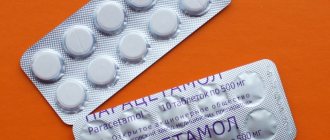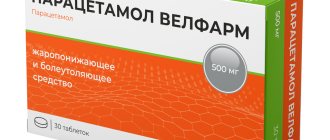Composition and dosage forms
Paracetamol is a substance from the non-steroidal non-narcotic group of analgesics with a pronounced antipyretic effect. Available in several pharmaceutical forms:
- tablets for oral administration: contain 200 or 500 mg of the active ingredient, packaged in blisters or packaging without cells;
- capsules: hard shell 500 mg;
- syrup and suspension: sweetish-tasting liquid, contains 2.4% paracetamol (24 mg per 1 ml), packaged in glass bottles of 50 and 100 ml;
- 1.5 percent aqueous solution for infusion: colorless transparent liquid in ampoules of 5 ml;
- rectal suppositories: in a dosage of 50–500 mg, packaged in cell contour plates.
In what cases is it effective?
The drug has an effect in various febrile conditions associated with elevated temperature. Particularly effective for colds.
Paracetamol is able to cope with pain of varying intensity. It is often used for headaches and toothaches. Helps women with pain during menstruation.
The drug is allowed to be taken by pregnant women and babies from 3 months. For children there are baby candles and syrup. The product is often given to babies who are starting to cut their teeth.
Mechanism of action
The anti-inflammatory effect of the drug is insignificant. Paracetamol mainly acts as an antipyretic and a mild analgesic. A derivative of phenacetin inhibits the production of compounds in the body that are responsible for sensitivity to pain - prostaglandins. At the same time, it affects the thermoregulation centers, reducing high body temperature.
The drug helps with pain syndromes of various origins:
- neuralgia;
- myalgia;
- joint pain;
- algomenorrhea;
- renal colic;
- toothache;
- febrile conditions accompanying acute respiratory viral infections and other infectious lesions.
Paracetamol is quickly absorbed into the blood, does not accumulate in the body, and does not irritate the mucous membranes of the gastrointestinal tract. Metabolized in the liver. It is completely eliminated 4–5 hours after administration. The drug has a symptomatic effect: it relieves acute signs of diseases for a certain time, without affecting their intensity and duration.
Paracetamol
Symptoms
The clinical picture of acute overdose develops within 24 hours after taking paracetamol. Gastrointestinal disorders appear (nausea, vomiting, loss of appetite, discomfort in the abdominal cavity and (or) abdominal pain), pallor of the skin. When administered simultaneously to adults of 7.5 g or more or to children of more than 140 mg/kg, cytolysis of hepatocytes occurs with complete and irreversible liver necrosis, the development of liver failure, metabolic acidosis and encephalopathy, which can lead to coma and death. Ingestion of 5 g or more of paracetamol can lead to liver damage in the presence of risk factors (long-term treatment with carbamazepine, phenobarbital, phenytoin, primidone, rifampicin, St. John's wort or other drugs that are inducers of microsomal liver enzymes; ethanol abuse, glutathione deficiency, digestive disorders , cystic fibrosis, HIV infection, fasting, cachexia). 12-48 hours after the administration of paracetamol, there is an increase in the activity of microsomal liver enzymes, lactate dehydrogenase, bilirubin concentration and a decrease in prothrombin content. Clinical symptoms of liver damage appear 2 days after an overdose of the drug and reach a maximum on days 4-6. In case of overdose, intoxication is possible, especially in elderly patients, children, patients with liver diseases (caused by chronic alcoholism), in patients with nutritional disorders, as well as in patients taking inducers of microsomal liver enzymes, and fulminant hepatitis, liver failure, cholestatic hepatitis. cytolytic hepatitis, sometimes fatal. In severe cases of overdose, encephalopathy (impaired brain function), cerebral edema, bleeding, hypoglycemia, and even death may develop as a result of liver failure. It is possible to develop acute renal failure with acute tubular necrosis, the characteristic signs of which are pain in the lumbar region, hematuria (admixture of blood or red blood cells in the urine), proteinuria (increased protein in the urine), while severe liver damage may be absent. There have been cases of heart rhythm disturbances and pancreatitis.
Treatment
Immediate hospitalization. If you suspect an overdose, even in the absence of pronounced first symptoms, you must stop using paracetamol and immediately seek medical help. The level of paracetamol in the blood plasma should be determined, but not earlier than 4 hours after the overdose (earlier results are unreliable). Laboratory tests of liver microsomal enzyme activity should be performed at the beginning of treatment and then every 24 hours. The introduction of SH-group donors and precursors for the synthesis of glutathione-methionine and acetyl cysteine is most effective in the first 8 hours.
Symptomatic treatment: within 1 hour after an overdose, it is recommended to lavage the stomach and take enterosorbents (activated carbon and others). In most cases, the activity of microsomal liver enzymes returns to normal within 1-2 weeks. In very severe cases, a liver transplant may be required. Administration of acetylcysteine within 24 hours of an overdose. The maximum protective effect is provided during the first 8 hours after an overdose; over time, the effectiveness of the antidote drops sharply. If necessary, acetylcysteine is administered intravenously.
In the absence of vomiting, methionine can be used before the patient is admitted to the hospital. The need for additional therapeutic measures (further administration of methionine, intravenous administration of acetylcysteine) is determined depending on the concentration of paracetamol in the blood, as well as the time elapsed after its administration. Treatment of patients with severe liver dysfunction 24 hours after taking paracetamol should be carried out in conjunction with specialists from a poison control center or specialized liver disease department.
How does poisoning develop?
The first symptoms of paracetamol poisoning are nausea and vomiting. Diarrhea may then develop. Consciousness is not confused, however, patients complain of epigastric pain and general malaise. Within a few hours, the signs of poisoning disappear, however, in fact, there is no improvement.
After a day or two, a picture of toxic liver damage develops, which requires immediate consultation with a doctor who will prescribe a course of treatment for toxic hepatitis.
Without appropriate therapy, extensive liver necrosis and multiple kidney and myocardial lesions are possible. The disease progresses sharply until the development of hepatic coma and death of the patient. According to statistics in the United States, paracetamol poisoning is the second most common cause of death after poisoning by alcohol and its surrogates.
There are also cases where necrosis developed after chronic poisoning with paracetamol, that is, the patient regularly took high doses of the drug. Most often, this poisoning was associated with drinking alcohol.
Question answer
- How to take Paracetamol for children?
The instructions for the drug indicate the dosage regimen for children. It is important for parents to remember that up to 6 years of age, a child can only take Paracetamol syrup, and at the age of 6 to 12 years, the dosage of the drug is calculated individually.
- How often can I take the drug?
When the temperature rises, the drug is allowed to be taken every 4 hours (2 tablets at a dose of 200 mg, one tablet - 500 mg). The maximum daily dose should not exceed 4 g.
- How many days can you take Paracetamol?
You are allowed to take the drug for no more than 3 days in a row. If fever or pain does not subside, you should consult a doctor.
Interactions
The rate of absorption of paracetamol may be increased when used simultaneously with metoclopramide and domperidone and decreased when used with cholestyramine.
The anticoagulant effect of warfarin and other coumarins may be enhanced by long-term regular use of paracetamol with an increased risk of bleeding. Periodic use does not cause a significant effect.
Barbiturates reduce the severity of the antipyretic effect of paracetamol.
Anticonvulsants (including phenytoin, barbiturates, carbamazepine), which stimulate the activity of microsomal liver enzymes, may increase the toxic effect of paracetamol on the liver as a result of an increase in the degree of conversion of the drug into hepatotoxic metabolites. With the simultaneous use of paracetamol with hepatotoxic drugs, the toxic effect of the drugs on the liver increases.
The simultaneous use of high doses of paracetamol with isoniazid increases the risk of developing hepatotoxic syndrome.
Paracetamol reduces the effectiveness of diuretics.
Note!
Description of the drug Paracetamol-Darnitsa table. 500 mg No. 10 on this page is a simplified author’s version of the apteka911 website, created on the basis of the instructions for use.
Before purchasing or using the drug, you should consult your doctor and read the manufacturer's original instructions (attached to each package of the drug). Information about the drug is provided for informational purposes only and should not be used as a guide to self-medication. Only a doctor can decide to prescribe the drug, as well as determine the dose and methods of its use.
Pharmacodynamics
The drug belongs to the group of non-narcotic analgesics - the drug has an analgesic effect. Paracetamol has a pronounced antipyretic and analgesic effect. The biochemical basis of these reactions is inhibition of cyclooxygenase (one of the leading enzymes responsible for the synthesis of prostaglandins - mediators of inflammation).
Thus, the synthesis of prostaglandins is inhibited in the nervous system, which, moreover, have a pyrogenic effect (leading to an increase in temperature) on the hypothalamus, where the thermoregulation center is located. The hypothalamus is a brain structure responsible for both maintaining the required body temperature and producing certain hormonal factors. Inhibition of prostaglandin synthesis leads to a decrease in their pyrogenic effect on the hypothalamus, heat transfer from the body increases, and temperature decreases.
In parallel, Paracetamol affects the conduction of pain sensitivity impulses along afferent nerve fibers. This mechanism of action provides an analgesic effect.
Research is being conducted on the effect of Paracetamol on the serotonin system, as well as cannabinoid transmission in the brain.
Reviews
As soon as the temperature starts to rise, I take Paracetamol, and its rise immediately slows down. An effective and inexpensive product!
I always use Paracetamol if I feel like I'm starting to get sick. It reduces the temperature perfectly, and if you need to reduce it again, the drug can be taken every 4 hours.
I like the price of Paracetamol. The drug is absolutely accessible to all people due to its low price.


